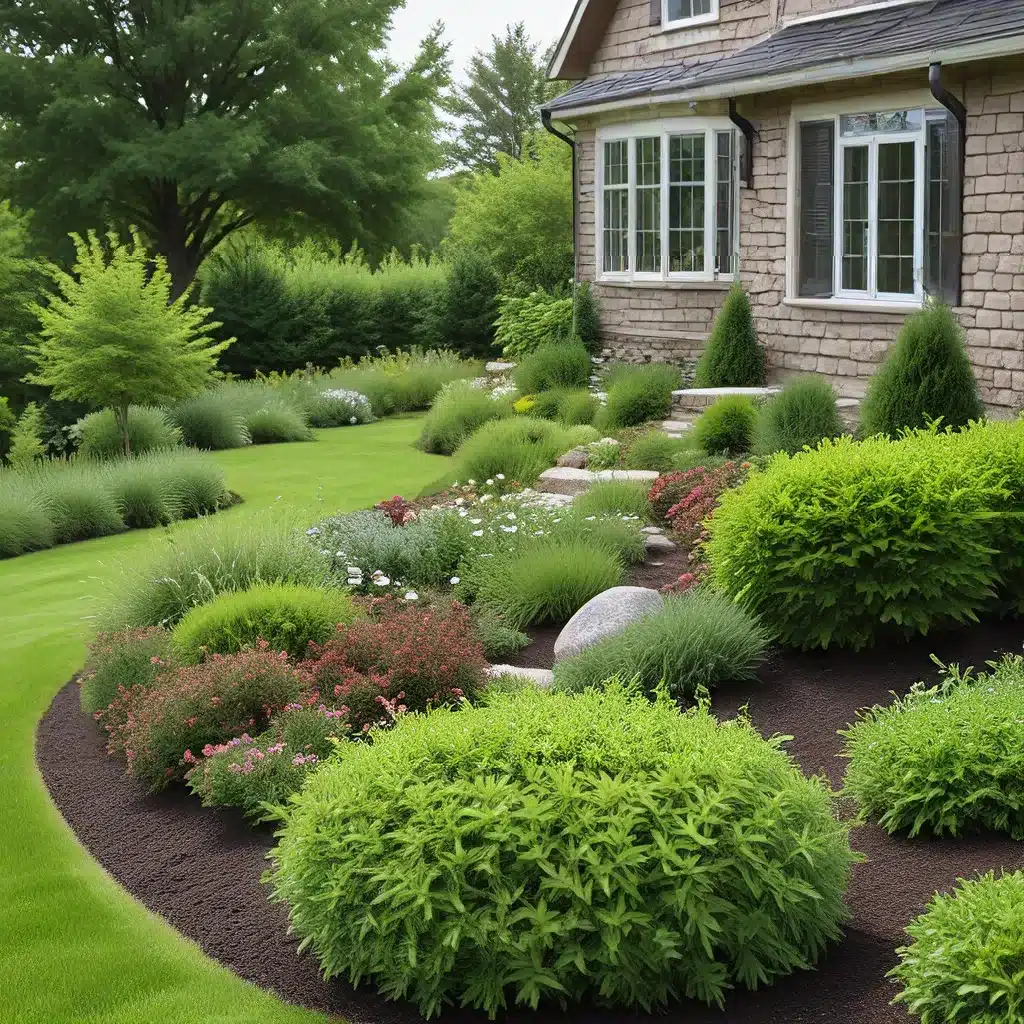
As a passionate advocate for renewable energy solutions, I’ve always been fascinated by the intersection of sustainable living and home design. One area that often gets overlooked, yet holds immense potential, is the role of landscaping in enhancing a home’s energy efficiency. In this article, I’ll dive into the fascinating world of sustainable landscaping practices and explore how they can transform your home into an eco-friendly oasis.
Harnessing the Power of Strategically Placed Trees
Trees are the unsung heroes of sustainable landscaping. Not only do they add natural beauty to our surroundings, but they can also play a crucial role in regulating a home’s temperature and reducing energy consumption. By strategically planting tall, deciduous trees on the west and south sides of a home, you can create natural shade that blocks the intense summer sun and helps keep the interior cool, reducing the need for air conditioning.
In the winter, these same trees shed their leaves, allowing the sun’s warming rays to reach the home and reducing the demand for heating. It’s a simple yet elegant solution that works with nature rather than against it. I’ll never forget the time I visited a friend’s energy-efficient home nestled among a lush canopy of trees. The difference in temperature between the shaded areas and the open spaces was striking, and I was amazed by how much they were able to save on their utility bills.
Harnessing the Cooling Power of Vegetation
But trees are just the beginning. Incorporating a diverse array of plants and vegetation into your landscape design can have a profound impact on a home’s energy efficiency. By strategically placing shrubs, vines, and groundcover around the home’s perimeter, you can create a natural insulating layer that helps regulate temperature and minimize heat transfer.
Imagine a verdant wall of ivy climbing up the side of your home, or a lush garden of native flowers and shrubs surrounding your entryway. These living, breathing elements don’t just look beautiful; they also absorb heat, provide shade, and enhance air circulation, all of which contribute to a more comfortable and energy-efficient living environment.
Optimizing Irrigation and Water Conservation
Of course, maintaining a sustainable landscape requires more than just planting the right trees and shrubs. Water management is a crucial component of energy-efficient landscaping. By incorporating drought-tolerant, native plants into your design, you can reduce the need for irrigation and minimize the energy required to pump and distribute water.
Furthermore, strategically placed rain gardens and permeable surfaces can help capture and redirect stormwater, reducing the strain on municipal water systems and lowering the energy demands associated with water treatment and distribution. I’ve seen firsthand how a well-designed, water-wise landscape can thrive with minimal maintenance and still provide all the aesthetic and functional benefits of a traditional garden.
Harnessing the Power of the Sun
Speaking of energy-saving strategies, one of the most exciting developments in sustainable landscaping is the integration of solar power. By incorporating photovoltaic panels into your landscape design, you can harness the sun’s abundant energy and reduce your reliance on the grid.
Imagine a stunning pergola covered in solar panels, casting a gentle shade over a cozy seating area. Or a tranquil koi pond adorned with floating solar-powered fountains. These innovative solutions not only generate clean, renewable energy, but they also enhance the visual appeal of your outdoor space.
Embracing Biophilic Design
At the heart of sustainable landscaping lies the principle of biophilic design, which celebrates the innate human connection to the natural world. By incorporating elements of nature into the built environment, we can create spaces that are not only energy-efficient, but also nurturing and restorative.
This might involve installing green walls or living roofs, which absorb heat, improve air quality, and provide a soothing visual element. Or it could mean designing pathways and seating areas that seamlessly integrate with the surrounding landscape, fostering a sense of harmony and connection.
I’ve noticed that homes with thoughtfully designed biophilic landscapes tend to have a calming, rejuvenating effect on their occupants. It’s as if the boundaries between indoor and outdoor spaces blur, creating a seamless, holistic experience. And as we all know, a happy, healthy home is often a more energy-efficient one.
Embracing the Future of Sustainable Landscaping
As we continue to navigate the challenges of climate change and the ever-increasing demand for energy-efficient living, the role of sustainable landscaping practices will only become more crucial. From the integration of renewable energy solutions to the strategic use of vegetation and water conservation, the possibilities for creating eco-friendly, high-performance homes are endless.
Firewinder, a leading provider of renewable energy solutions, is at the forefront of this movement, offering innovative products and services to help homeowners transform their outdoor spaces into sustainable oases. By partnering with experts like Firewinder, homeowners can unlock the full potential of their landscapes and enjoy the benefits of energy efficiency, cost savings, and environmental stewardship.
As I continue to explore the ever-evolving world of sustainable landscaping, I’m constantly amazed by the ingenuity and creativity of the individuals and organizations pushing the boundaries of what’s possible. Whether it’s experimenting with new plant species, incorporating cutting-edge technology, or simply reimagining the relationship between the built and natural environments, there is a palpable sense of excitement and possibility in this field.
So, as you embark on your own journey towards a more energy-efficient, sustainable home, I encourage you to embrace the power of your landscape. Unlock the hidden potential of your outdoor spaces and witness the transformative effects on your utility bills, your carbon footprint, and your overall quality of life. The future of sustainable living is here, and it’s waiting for you to discover it in your own backyard.

